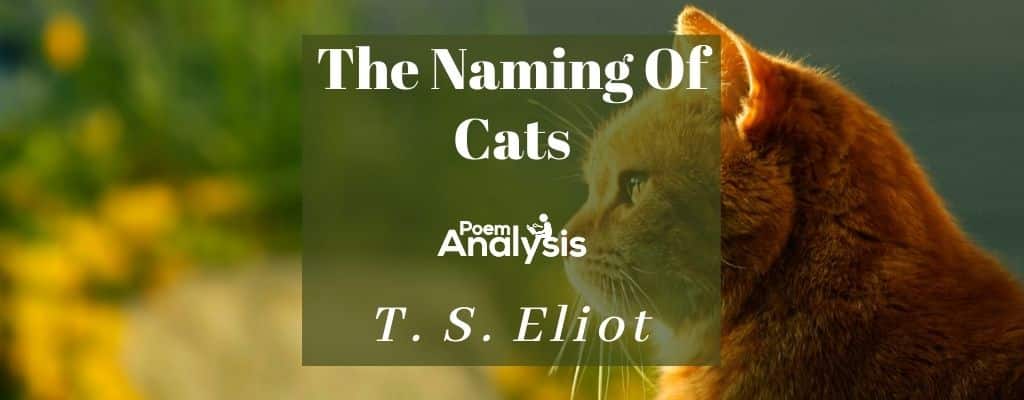‘The Naming of Cats’ was published in 1939. It was featured in a poetry collection called ‘Old Possum’s Book of Practical Cats’. This collection contains whimsical poems about feline psychology and sociology. T. S. Eliot’s poem shows the mysteriousness and deviousness of cats. Most of the poems in ‘Old Possum’s Book of Practical Cats’ were written in the 1930s and included in letters to T. S. Eliot’s godchildren. In 1939, these were collected and published.
The Naming Of Cats T. S. EliotThe Naming of Cats is a difficult matter, It isn’t just one of your holiday games;You may think at first I’m as mad as a hatterWhen I tell you, a cat must have THREE DIFFERENT NAMES.First of all, there’s the name that the family use daily, Such as Peter, Augustus, Alonzo, or James,Such as Victor or Jonathan, George or Bill Bailey— All of them sensible everyday names.There are fancier names if you think they sound sweeter, Some for the gentlemen, some for the dames:Such as Plato, Admetus, Electra, Demeter— But all of them sensible everyday names,But I tell you, a cat needs a name that’s particular, A name that’s peculiar, and more dignified,Else how can he keep up his tail perpendicular, Or spread out his whiskers, or cherish his pride?Of names of this kind, I can give you a quorum, Such as Munkustrap, Quaxo, or Coricopat,Such as Bombalurina, or else Jellylorum— Names that never belong to more than one cat.But above and beyond there’s still one name left over, And that is the name that you never will guess;The name that no human research can discover— But THE CAT HIMSELF KNOWS, and will never confess.When you notice a cat in profound meditation, The reason, I tell you, is always the same:His mind is engaged in a rapt contemplation Of the thought, of the thought, of the thought of his name: His ineffable effable EffanineffableDeep and inscrutable singular name.
The first edition of ‘Old Possum’s Book of Practical Cats’ was illustrated by the author, but when it was re-published in 1940, it was fully illustrated by Nicolas Bentley. Later editions include illustrations by Edward Gorey (1982) and Axel Scheffler (2009). ‘Old Possum’s Book of Practical Cats’ includes 15 poems. The last one in the collection, ‘Cat Morgan Introduces Himself‘, was added in the 1952 edition.
‘The Naming of Cats’, and the rest of Old Possum’s Book of Practical Cats, was adapted for the stage by Andrew Lloyd Webber. Lloyd Webber’s approach to the text is the best-known musical adaptation of these poems. As well as the poems featured in the collection, Lloyd Webber’s musical introduces characters from Eliot’s own unpublished drafts. Furthermore, ‘The Naming of Cats’ is also referenced in several films, including Logan’s Run.
‘The Naming of Cats’ has a great number of literary devices, such as allusions, similes, and repetitions, among others. Moreover, personification is one of the main literary devices, as cats are given human characteristics. The lyrical voice acquires a didactic but playful tone. He/she explains the naming of cats, but at the same time, he/she plays with external references and different types of allusions. The rhyme scheme of the poem is ABAB, and it produces a short and rhythmical dialogue.
Detailed Analysis
‘The Naming of Cats’ is presented in one big text portion and can be read in full here. Although the partition in stanzas can be made following the rhyme scheme, the poem is not printed with those spaces. Therefore, the poem will be analyzed as a whole, but those further partitions can be made. ‘The Naming of Cats’ explores the way in which cats acquire their names. The lyrical voice explains how a cat has three different names: the name they are given by their human family, a particular name, and an unknown name for humans.
The poem begins by stating the importance of the naming of cats:
The Naming of Cats is a difficult matter,
It isn’t just one of your holiday games;
There is an allusion to ‘Alice in Wonderland’ to compare the reader’s possible thoughts while reading to a reference he/she knows and has read about (“You may think at first I’m as mad as a hatter”). Notice the emphasis made in capital letters on the number of names that a cat has. The capitalization of phrases is crucial for the poem, as it stresses important information. Then, the lyrical voice talks about the first name: the family name. Notice the repetition in the syntax when the lyrical voice is giving examples of names (“Such as…”/ “All of them sensible everyday names”). These repetitions and the rhyme scheme create a particular rhythmical pace in the poem, which is almost song-like.
Then, the lyrical voice proceeds to talk about the second name a cat has. This name is a peculiar name that the cat possesses. The lyrical voice stresses the importance of this name, as it brings pride to the cat. This name is also very important, as it never belongs to more than one cat. The syntax repetitions are made once again to continue the rhythmical pace and the metrical form of the poem. The names given as examples are a bit eccentric, and they separate themselves from general knowledge, contrary to the ones given as examples of the first name. As the poem advances, the things that the lyrical voice mentions and the references he/she makes are more and more unknown to the reader.
Finally, the lyrical voice talks about the last name. There is an emphasis made on the impossibility of knowing this name (“And that is the name that you never will guess;/The name that no human research can discover”) and on the knowledge that the cat has of it (“But THE CAT HIMSELF KNOWS, and will never confess”). There is some mystery about this final name, as the narrator states that it will never be known to humans. The rhythm changes a little, and the repetition is not found in the syntax but in words (“Of the thought, of the thought, of the thought of his name:/His ineffable effable/Effanineffable”). This change in rhythm and structure allows the lyrical voice to finish the poem dramatically and capture his/her reader’s attention.
About Thomas Stearns Eliot
Thomas Stearns Eliot was born in 1888 and died in 1965. He was a British essayist, publisher, playwright, literary and social critic. Although born in the United States of America, he became a British citizen in 1927. T. S. Eliot moved to England in 1914 at the age of 25 and stayed there until his death. He is known as one of the most important poets of the twentieth century. T. S. Eliot was one of the key figures in the modernist movement of the early 1900s. His most famous poems include ‘The Love Song of J. Alfred Prufrock‘, ‘The Waste Land‘, ‘The Hollow Men‘, ‘Ash Wednesday‘ and ‘Four Quartets’, among many others. T. S. Eliot won the Nobel Prize in Literature in 1948. You can read more about T.S. Eliot’s poetry here.





sup
The sky?
Can you please tell the figure of speeches used in this poem one by one and line to line.
In the third line, it uses the phrase, “mad as a hatter” which is a figure of speech taken from Alice in Wonderland by Lewis Carroll. Cherish his pride sounds like a figure of speech, although not one I’m familiar with – that occurs in line 16. In line 21 the phrase, “above and beyond” is used. This means going beyond what is expected. Hope that helps.
What tipe Of poem is it
It’s a comical poem. I’m not sure how else to classify it it!